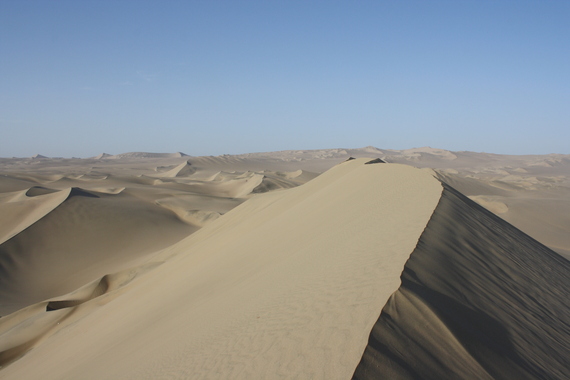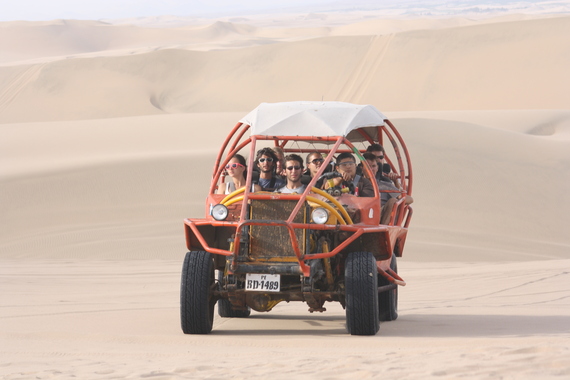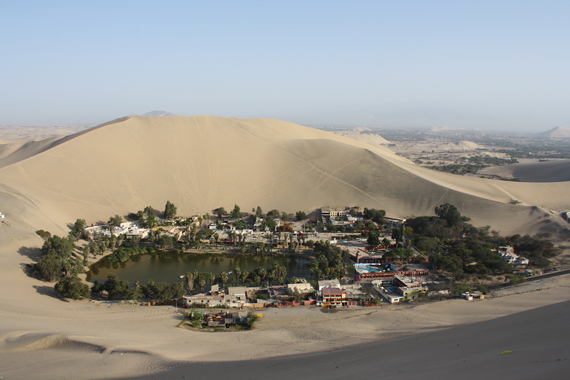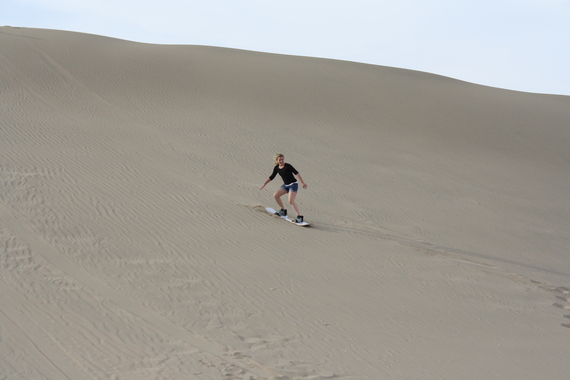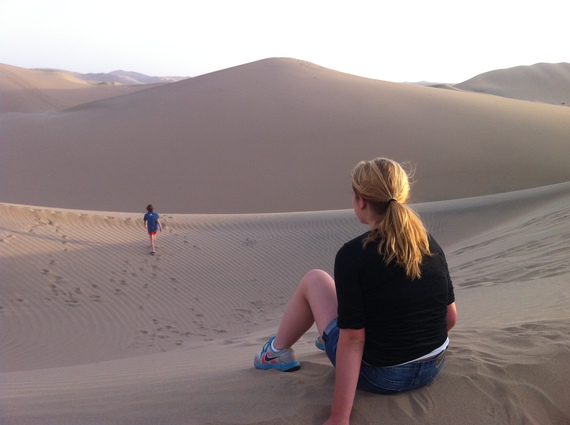Looking for something a little different and a lot off the beaten track this summer? Try sandboarding in the Peruvian dessert.
It's a scene right out of Lawrence of Arabia: enormous mountains of sand -- some as tall as 300 feet -- their surface sculpted into soft, geometric designs by the wind, and extending as far as the eye can see. My wife and I stand captivated, feeling the heat of the day rising up out of the soft sand and watching the interplay of golden light and pale shadow as the sun dips behind a distant ridge of solid beige.
Of course, there were also a few differences. For starters, this is not the great Sahara Desert, but the northernmost stretches of the even longer, but not as wide, Atacama Desert in southern Peru. And when it is time to return to our oasis, we climb not back onto camels, but into equally curiously-shaped, 10-passenger dune buggies. Nor will it be a leisurely plod back, but a wild ride up -- and especially down - a Bedouin's dozen more dunes, our hands clenched tightly to the cushioned bars in front of us and screams of delight issuing involuntarily from the mouths of our internationally-diverse fellow passengers. Peter O'Tooles we definitely weren't.
For nearly two weeks, Huacachina had been dangled as a reward to our twin daughters for all the "ordeals" we had subjected them to: eight hours wandering the ruins of Machu Picchu, a day-long boat trip across Lake Titicaca, and a 15-hour minivan tour of the amazingly deep (11,000-feet) Colca Canyon. After a second overnight bus ride, they had certainly earned it. And we all needed to end our trip on a piercing high note.
Naturally I was worried that Huacachina wouldn't be anywhere near as compelling as it looked in the guide books. Fortunately, I was wrong. Towering dunes of beach-quality sand encircle the palm, jacaranda and bougainvillea-laden oasis on three sides. The fourth, through which the road to Ica (three miles distant) passes is small by comparison, but still sufficient to block the view and create the impression of complete isolation. What little there is of the town wraps itself around three sides of a murky green lagoon of mythical origins (the name means "crying woman" in Quechua) whose allegedly curative waters once attracted ailing Peruvian elites.
These days, however, it's Huacachina's sand that's attracting thrill-seeking foreigners. While the girls cool off in the pool, I set off to arrange our afternoon dune buggy/sandboarding excursion. In fact, there wasn't much arranging to do. Just about every accommodation in town will do it for you, and it's all the same tour anyway. All you have to do is negotiate your price downwards from the asking price, which in December was only 30 soles ($12).
At 4:00 p.m., our driver, Francisco, swings by our hotel in his neon orange buggy, a racked, open-air contraption that rumbles with power. Two hotels later, we are full. Francisco loops around to the other side of town where we pay our nominal municipal tax, and wait, engines throbbing, until the full caravan of dune buggies -- about 20 of them -- has assembled. Then, in an explosion of noise, color and palpable excitement, we roar off into the desert.
For the next 30 minutes, Francisco delivers big-time on the "adrenaline-stirring" promise of the tour, tearing up, down and over a succession of serious sand as we in the back brace ourselves as best we can as we are jostled every which way. Finally, after one particularly rollicking and well-received descent, he stops at the top of a small dune so that we can try our luck at sandboarding.
Like snowboarding, sandboarding requires strapping your shoes into set grips atop a three-foot, wooden board. Then all you have to do is maintain your balance while gravity does the work. Needless-to-say, this is easier said than done, so first-timers like us appreciated the option of taking the first two runs on our stomachs with our legs splayed out behind to use as brakes. By now we are ready to try standing up, and with fairly satisfactory results -- surfing straight down for about 20 or 30 yards until friction arrested our momentum and we toppled over.
From there, we are driven to a series of increasingly steeper dunes, with increasingly less innocuous results, including some rather unpleasant face-plants. By the time we arrive at our last run of the day -- a black diamond to be sure -- not even the two accomplished Korean snowboarders in our group are willing to take it any way but lying down. Our legs tired from trudging, our egos bruised from the falls, and our clothes infused with thousands of grainy souvenirs, we gladly relax to watch the sunset.
And no one is more glad than I that Huacachina has been such a big hit -- a sand blast, in fact -- with another round of thrills still to come. By the time we are dropped off at our hotel, we have two very happy campers -- and two contented parents looking forward to a cold beer and an exceedingly atmospheric night at a real oasis.
Going to Huacachina
Getting there: Huacachina is located three miles southwest of Ica, which is roughly 175 miles south of Lima via the Pan-American Highway. Bus fares from Lima to Ica range from to $10-$30 with the trip taking 4-6 hours. From Ica, the set taxi fare is 7 soles ($3). Information: www.huacachina.com
Marshall S. "Mike" Berdan is a travel writer based in Connecticut who also writes about American history and culture. His first book is the award-winning Raising Global Children, which was published by the American Council on the Teaching of Foreign Languages (November 2013).
